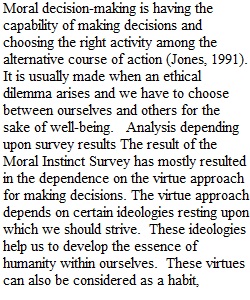


Q Evaluate 1. The moral instincts survey captures several key ethical theories that are discussed in your textbook and readings. In preparation for this journal entry complete the 15-item Moral Instinct SurveyDownload 15-item Moral Instinct Survey [DOCX file, size 36 KB]. The document can be printed and you can circle your answers, or you can bypass printing and save your answers to a sheet of paper so that you can refer to them as you answer the following questions. 2. In your journal, reflect on the following questions and post your observations and thoughts. o What were your results from the Moral Instincts Survey? (i.e. which of the four approaches did you use most often?) o Were you surprised by your results? o Did it validate what you already knew? o Which approach did you use least often? ________________________________________ Compose your work in a .doc or .docx file type using a word processor (such as Microsoft Word, etc.). Check your work and correct any spelling or grammatical errors. Evaluation The Journal assignment is worth 5% of your overall grade. Journal entries will be evaluated utilizing the Journal Rubric that can be found on the Rubrics page within the Course Introduction module area in the course. Please review this rubric prior to beginning your work. This journal entry assesses the following module outcomes: • M1-01: Differentiate between morals, ethics, and cultural and ethical relativism as they apply in a professional setting. (CO2) • M1-02: Distinguish between informed and conversational opinions and use critical thinking and analysis skills to identify faulty rationales. (CO3) References Outcomes RubricDownload Rubric Return to Learning Pathway Rubric HSC 312 Journal Reflection Rubric HSC 312 Journal Reflection Rubric Criteria Ratings Pts This criterion is linked to a Learning OutcomeRelevance & Depth 40 pts A: Provides a clear and comprehensive reflection to the assigned question(s) that addresses the learning experience and its value for the student. 34 pts B: Provides a reflection for the assigned question(s) that addresses the learning experience and its value. Some minor details may be missing. 30 pts C: Provides a brief reflection for the assigned question(s); however, some areas are incomplete and reflection needs more detail. 26 pts D: Attempt at reflection addresses some of the questions and the learning experience; however, important details are vague or missing. Not all questions are answered. 22 pts F: Attempt at reflection addresses a few questions; however, answers are incomplete. Reader cannot ascertain the points the student is making. 0 pts 0: No reflection paper provided. 40 pts This criterion is linked to a Learning OutcomeConnections & Application 40 pts A: Extends the questions by making meaningful, detailed connections between the assigned questions/issue(s), knowledge of the topic/concepts, and personal experience. 34 pts B: Makes appropriate connections between the assigned questions/issue(s), knowledge of the topic/concepts, and personal experience. 30 pts C: Attempts to make connections between the assigned questions/issues and knowledge of the topic/concepts, and personal experience. More detail and clarification is needed to build a case for the connection(s). 26 pts D: Attempts to make connections between the assigned questions/issues and knowledge of the topic/concepts, and personal experience; however, reflection indicates misconceptions with the content. More detail and clarification is needed to build a case for the connection(s). 22 pts F: Connections are unclear and/or reflection indicates major misconceptions with the content. 0 pts 0: No reflection paper provided. 40 pts This criterion is linked to a Learning OutcomeOrganization & Communication 10 pts A: Writing is organized and skillfully communicates meaning to readers (e.g., clear focus of the topic, appropriate word choice, language flows seamlessly); all components of the assignment are addressed. 8 pts B: Writing is organized and generally conveys meaning to readers; all components of the assignment are addressed. 7 pts C: Writing is somewhat organized and generally conveys meaning to readers; most components of the assignment are addressed. 6 pts D: Writing attempts organization, but writing language errors or organization errors sometimes interferes with the meaning. Some components of the assignment are missing. 5 pts F: Written work does not progress logically and ideas are not fully formed; most of the components of the assignment are missing. 0 pts 0: No reflection paper provided. 10 pts This criterion is linked to a Learning OutcomeSyntax & Mechanics 10 pts A: Clearly and consistently uses proper grammar, spelling, and punctuation. 8 pts B: Uses proper grammar, spelling, and punctuation. There are a few minor errors; however, they do not interfere with meaning. 7 pts C: Generally uses proper grammar, spelling, and punctuation. There are a few errors that interfere with meaning. 6 pts D: There are many grammar, spelling, and punctuation errors that interfere with meaning. 5 pts F: The substantial number of grammar, spelling, and punctuation errors make the paper difficult to read. 0 pts 0: No reflection paper provided. 10 pts Total Points: 100 PreviousNext
View Related Questions